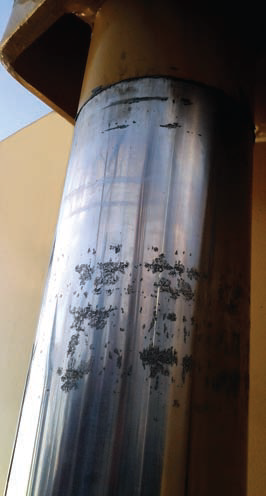
WMV Europe BV
Vital offshore surface protection
Founded in 1984, Dutch Galvanic plating firm WMV Europe BV has spent 29 years dedicated to the research and development of hard industrial coatings for the offshore oil and gas and marine industries.
Meeting the requirements of a challenging and demanding environment, these coatings offer an exceptional combination of non-stick, good wear resistance, anti galling and marine corrosion resistance. Highly suitable for harsh conditions, WMV coatings are smooth, pore free, relatively thick and can guarantee a weld-like bond.
Benefiting from its own research laboratory, WMV is dedicated to finding innovative coatings for machines and tools for companies worldwide. This commitment has proven highly fruitful, with WMV generating a huge amount of interest for its latest innovation, the semi-ceramic Lunac 2+ duplex coating. Aware that galvanic coatings offer cost efficient benefits as well as moderate up to sufficient corrosion resistance and reasonable to good scratch and wear resistance, the company also knew that delamination, limited salt water/ chloride resistance and pore issues with nickel – chromium coatings are regularly recorded. Looking to combine the strengths of galvanic coatings with the superior wear and tear resistance, anti-galling properties and high hardness of many HVOF ceramic coatings, WMV was also aware of the frequent brittleness issues and/or increased seal wear of most HVOF ceramic coatings, and has thus come very close to creating the ideal combination of vital properties in severe environments.
Viewed as one of the most innovative coating systems since the company’s inception, the partly ceramic, partly galvanic alloy, non-HVOF coating system boasts a unique combination of properties; developed to have a thick three layer (120-150 um) coating system that merges high hardness (Hv >1200/2100), anti-galling and weld quality bond properties with an almost unrivalled sub-surface corrosion protection capability, better known from zinc coatings. Furthermore, it is specifically friendly to seals, and is different to most full ceramic coatings as it  can even handle small accidents. These combined characteristics have given the Lunac 2+ duplex coating an excellent reputation for robustness in most offshore applications and resulted in the coating gaining one of the highest-level EPQ (NBD 10300) corrosion testing qualifications in the industry.
can even handle small accidents. These combined characteristics have given the Lunac 2+ duplex coating an excellent reputation for robustness in most offshore applications and resulted in the coating gaining one of the highest-level EPQ (NBD 10300) corrosion testing qualifications in the industry.
Following 14 years of continuous development, Lunac 2+ duplex comprehensively merges all of the required properties for an almost compromise-free coating for hydraulic equipment. When combined with ductile modified nickel and applied to hydraulic pistons, shafts and axles, the Lunac 2+ duplex has been described as one of the most superior and suitable materials in the market, particularly in offshore use involving heavy lift applications. Pistons up to 3920 millimeters can be (partially) plated in accordance with the Lunac 2+ duplo system (50 + 70/100 μm) and still be cut afterwards. Tests have shown that welding in close proximity to the coating zone is permissible, as is nitrogen cooling for shrinking. Meanwhile, lock door hinge-pins operating in sweet and salt water-air compounds inflict no damaged to the coating, as Lunac 2+ duplex is more corrosion resistant than most high-grade stainless steel.
Due to the company’s extensive database and six steps of dedicated alloy and tool steel pretreatment, which have been developed over the last 29 years, WMV is able to offer the very hard obtainable full substrate bond.
The typical characteristics of Lunac 2+ duplex coatings include high resistance to scratches by (quartz) sand, with the top layer showing an effective hardness of Hv2100 and a minimum matrix hardness of Hv1200. Showing 0.020 μm/min/gr/mm2 wear in an environment with SiO2 grit 400, 1.98 m/s, the Lunac 2+ coating’s abrasive wear resistance was a 23 fold better than hard chromium (0.460) or a 43 fold better than hardened DIN 1.2379 steel (0.860). Impressively, the Lunac 2+ duplex coating has also shown signs of partial self-healing properties in pores and small defects and can handle water/air interfaces at a satisfactory level.
With a special crystal structure and the modified ceramic content, the (non lubricated / non foreign particle) adhesive wear resistance of the Lunac 2+ coating is equal to most sintered technical ceramics adhesive wear resistance. The adhesive wear resistance increase compared to hardened steel DIN 1,2379 on 1,2379 HRc 68 at 0.25 MPa, 0.7 m/s is +/- 17 times. The Lunac 2+ duplex salt water corrosion protection capability is qualified according to the NBD 10300 (Rijkswaterstaat Netherlands 2010) or EPQ corrosion testing, based on ASTM G59- 97 (2003) /G61-86 (2003) and ISO 17475 standards and ASTM B117 1000 hours salt spray testing (in practice > 3100 hours rating 9-10), provided that the base steel is free of micro defects and ground to a low roughness beforehand. The final Lunac 2+ surface is smooth (Ra 0.11-0.3 μm) and the coating will not peel off even after a plastic deformation, however the top layer of the Lunac +2 can show microscopic cracks if stretched more than 0.28 per cent. Lunac 2+ duplex is designed to withstand the harshest of environments.
Although the outer Lunac 2+ surface becomes slightly tarnished following a long period of non-use or (sea) water contact, it is consideredas one of the most distinctive coatings for hydraulic cylinders and axles that has no major limitations. Attractively priced, it is scratch and corrosion resistant, seal-friendly and creates a weld-quality bond with the substrate. With 12 years of uninterrupted service already being reported by early users of Lunac 2+ mono, and two and half years of the latest ultimately corrosion resistant Lunac 2+ duplex version, both plating systems boasts truly ground breaking and unique properties.
WMV Europe BV
Services: Industrial coatings specialist